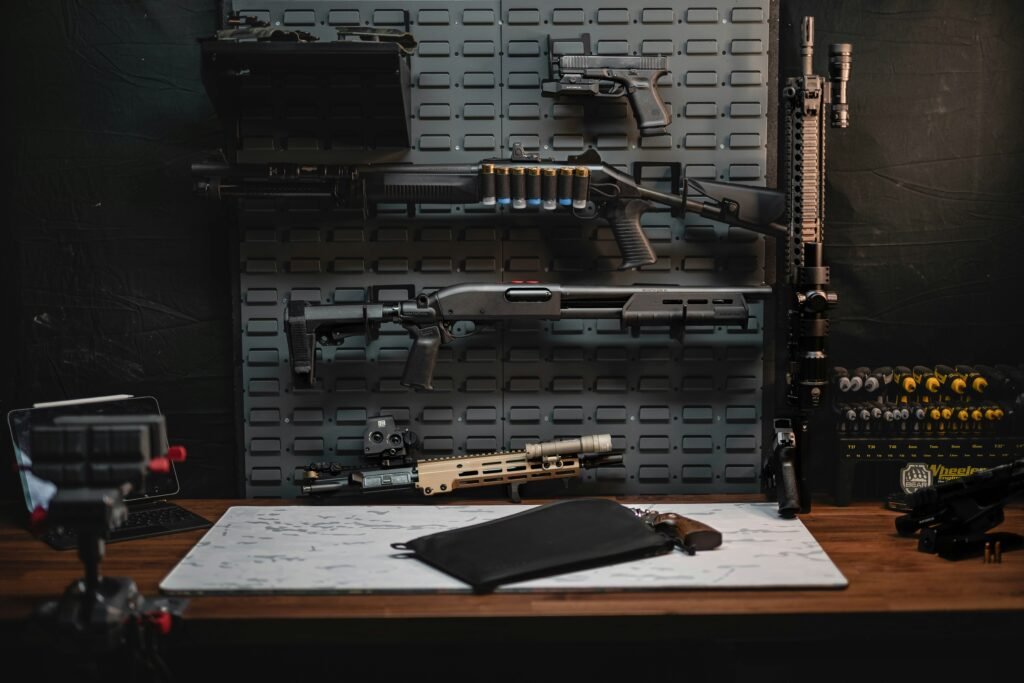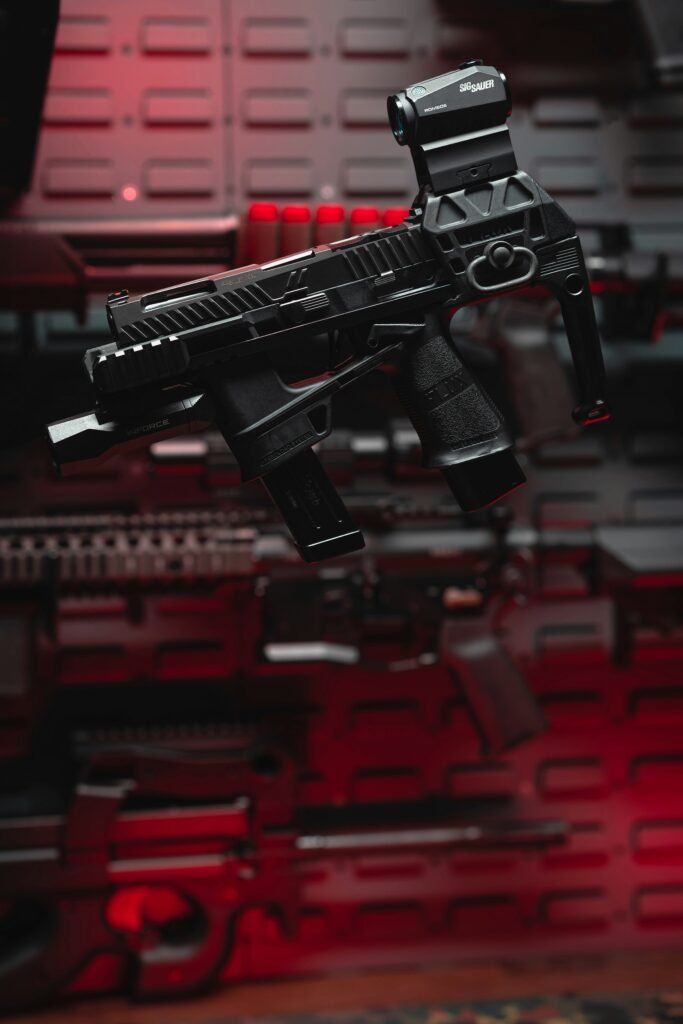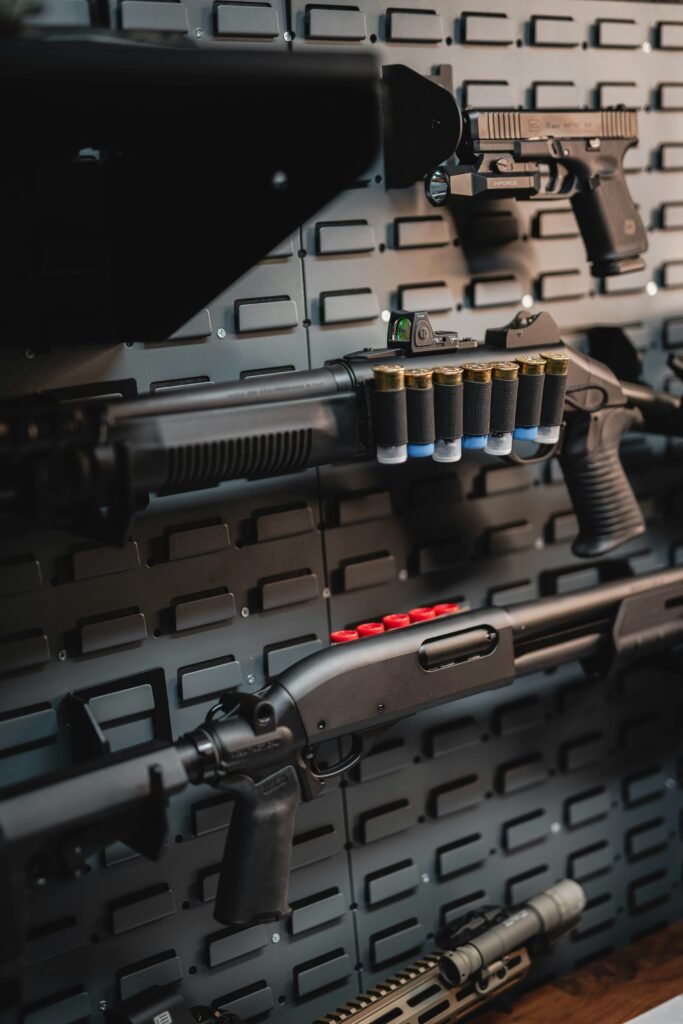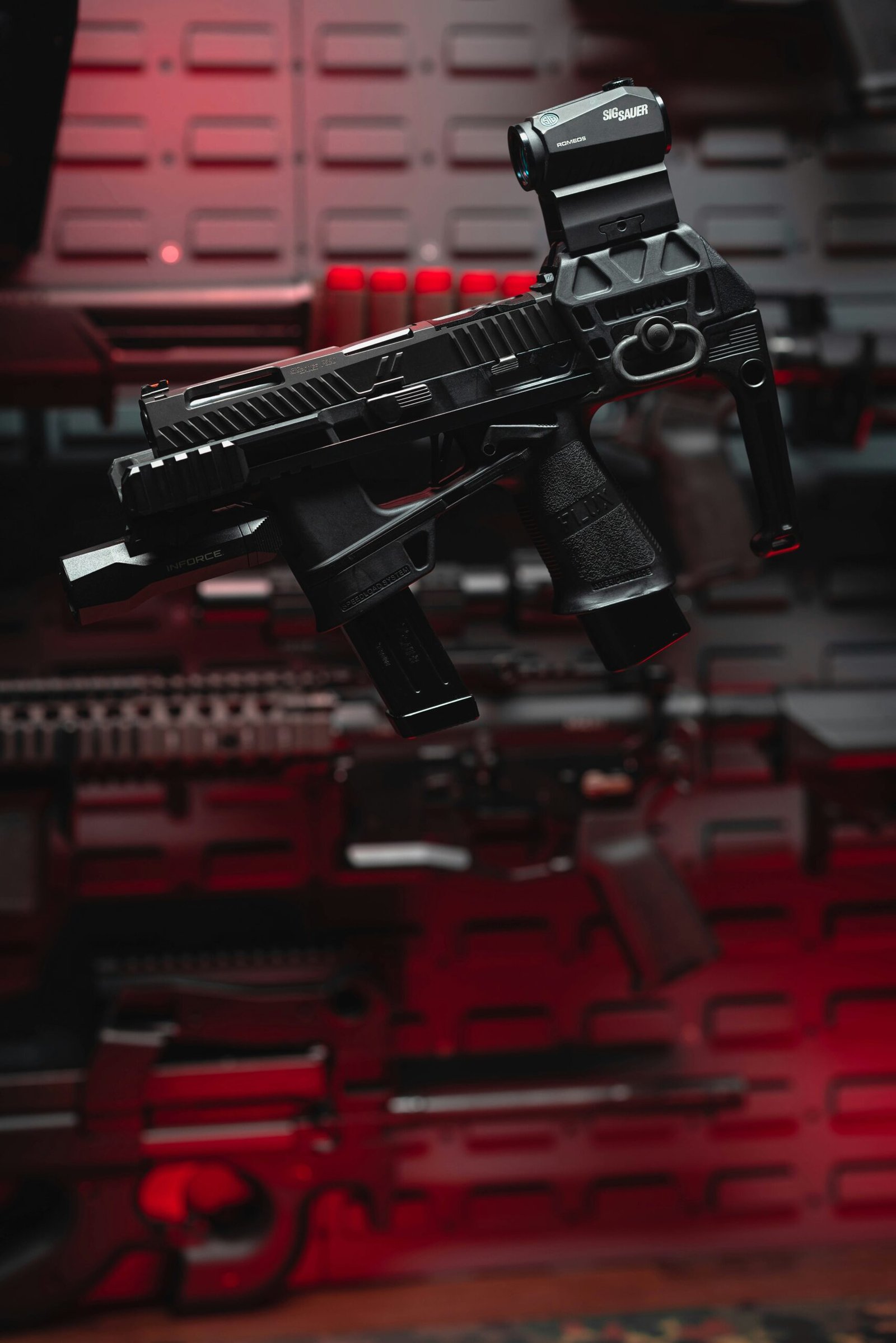Maintaining your gun safe is essential to ensure the long-lasting protection and functionality of your firearms. In this comprehensive guide, you will discover a range of routine maintenance tips that will help you keep your gun safe in top condition. From cleaning the interior and exterior surfaces to lubricating the locking mechanism, these simple yet effective practices will not only preserve the integrity of your gun safe but also guarantee quick and reliable access to your firearms whenever you need them. Don’t wait for a problem to arise – take proactive steps today to maintain your gun safe for years to come.

This image is property of images.unsplash.com.
Cleaning the Exterior
Removing dust and debris
To maintain the appearance and functionality of your gun safe, it is important to regularly clean the exterior. Start by removing any dust and debris that may have accumulated on the surface. Use a soft cloth or a brush to gently wipe away the dust, paying attention to the corners and crevices where dirt tends to gather.
Cleaning with a mild detergent
Once the dust is removed, you can proceed to clean the exterior with a mild detergent. Dilute the detergent in warm water and use a clean cloth or sponge to gently wipe the surface of the gun safe. Avoid using harsh chemicals or abrasive cleaners, as they may damage the finish of the safe. Rinse the cloth or sponge in clean water frequently to prevent the detergent from building up.
Drying and polishing the surface
After cleaning, make sure to thoroughly dry the exterior of the gun safe to prevent any water spots or streaks from forming. Use a dry and clean cloth to gently pat the surface dry. Once the safe is dry, you can polish the exterior using a safe-approved polish or wax. This will help protect the finish and give the safe a shiny appearance. Remember to follow the manufacturer’s instructions when choosing a polish or wax.
Inspecting the Lock Mechanism
Checking for any damage or wear
The lock mechanism is a crucial component of your gun safe, ensuring the security of its contents. Regularly inspect the lock for any signs of damage or wear. Look for rust, loose parts, or any abnormalities in the mechanism. If you notice any issues, it is important to address them promptly to prevent lock failure.
Testing the functionality
In addition to visual inspection, it is essential to test the functionality of the lock. Insert the key or enter the combination, depending on the type of lock you have, and make sure it operates smoothly. Try locking and unlocking the safe multiple times to ensure consistent performance. If you encounter any difficulties or inconsistencies, contact a professional locksmith for assistance.
Applying lubrication if necessary
If you notice any stiffness or resistance while using the lock, it may be an indication of insufficient lubrication. Apply a small amount of safe-approved lubricant to the lock mechanism, following the manufacturer’s instructions. This will help improve the ease of operation and prolong the lifespan of the lock. Avoid using WD-40 or similar products, as they can attract dust and debris, potentially compromising the lock’s performance.

This image is property of images.unsplash.com.
Checking the Hinges
Examining for any signs of wear
The hinges of your gun safe play a vital role in ensuring smooth operation and door stability. Regularly examine the hinges for any signs of wear, such as rust, loose screws, or squeaking sounds when opening or closing the door. If you notice any issues, it is important to address them promptly to prevent further damage to the hinges or the safe itself.
Tightening loose screws or bolts
Over time, the screws or bolts that secure the hinges may become loose due to repeated use or environmental factors. Inspect the hinge area and tighten any loose screws or bolts using the appropriate tools. This will help maintain the stability of the door and prevent unnecessary strain on the hinges, ensuring they continue to function properly.
Using lubrication to ensure smooth operation
To ensure the hinges operate smoothly, apply a silicone-based lubricant to the pivot points of the hinges. This will reduce friction and prevent squeaking or grinding sounds when opening or closing the door. Avoid using oil-based lubricants, as they may attract dust or dirt, which can interfere with the proper functioning of the hinges.
Examining the Interior
Removing and organizing firearm(s)
When maintaining your gun safe, it is important to remove any firearms before inspecting the interior. Clear the safe of all firearms and ammunition, and set them aside in a secure location. This will ensure the safety of both you and your firearms during the maintenance process. Take this opportunity to organize your firearms and accessories within the safe, making sure they are stored securely and efficiently.
Inspecting for any signs of corrosion or rust
With the firearms removed, carefully inspect the interior surfaces of the safe for any signs of corrosion or rust. Pay close attention to areas where moisture may accumulate, such as the bottom or corners of the safe. If you notice any rust or corrosion, it is essential to address it promptly to prevent further damage to your firearms.
Cleaning the interior surfaces
To clean the interior surfaces of the safe, use a soft cloth or a brush to remove any dust or debris. To remove stubborn stains or fingerprints, you can use a mild detergent diluted in warm water. Gently scrub the affected areas, being careful not to scratch the interior surfaces. After cleaning, make sure to thoroughly dry the interior before returning the firearms to the safe.

This image is property of images.unsplash.com.
Testing the Fireproofing
Verifying the fire rating of the safe
One of the critical features of a gun safe is its ability to provide fire protection for your firearms. Periodically verify the fire rating of your safe to ensure it meets your desired level of protection. This information can usually be found on a label or in the safe’s documentation. If you have any doubts about the fireproofing capabilities of your safe, consider consulting a professional or contacting the manufacturer.
Checking the seals and gaskets
To maintain the fire resistance of your safe, regularly inspect the seals and gaskets around the door. Look for any signs of wear, damage, or gaps that may compromise the effectiveness of the seal. Proper seals and gaskets are essential in preventing smoke and fire from entering the safe’s interior.
Testing the safe’s fire resistance
Periodically, and especially after any significant changes or modifications to your safe, it is important to test its fire resistance. This can be done by exposing the safe to a controlled heat source or consulting a professional testing service. By verifying the fire resistance of your safe, you can have peace of mind knowing that your firearms and valuables are adequately protected.
Maintaining the Electronic Keypad
Checking the battery level regularly
If your gun safe has an electronic keypad, it is crucial to regularly check the battery level to ensure uninterrupted operation. Most electronic keypads have a low battery indicator that will alert you when it’s time to replace the batteries. Follow the manufacturer’s instructions to safely replace the batteries, ensuring the keypad remains functional at all times.
Cleaning the keypad surface
Dirt, dust, and oils from your fingers can accumulate on the keypad’s surface, potentially affecting its performance. Regularly clean the keypad using a soft cloth dampened with a mild detergent or specialized electronic cleaner. Gently wipe the surface, paying attention to the buttons and crevices. Avoid using excessive moisture, as it can potentially damage the keypad.
Resetting the access code periodically
For improved security, consider periodically resetting the access code to your gun safe. This prevents unauthorized access and ensures that only authorized individuals have knowledge of the code. Follow the manufacturer’s instructions to reset the access code, and make sure to choose a combination that is unique and not easily guessable.
Monitoring Humidity Levels
Using a dehumidifier
High humidity levels can lead to moisture buildup inside your gun safe, increasing the risk of corrosion or rust on your firearms. To mitigate this, consider using a dehumidifier within your safe. There are various types available, including electric dehumidifiers, silica gel packs, or desiccant pouches. Follow the manufacturer’s instructions and replace or recharge the dehumidifier as necessary to maintain optimal humidity levels.
Checking humidity levels with hygrometer
To ensure the effectiveness of your dehumidifier and monitor the humidity levels inside your safe, use a hygrometer. This device measures the relative humidity, allowing you to determine if additional measures are necessary. Aim to keep the humidity level below 50% to prevent moisture-related damage to your firearms.
Applying rust prevention measures if needed
If you live in an area with high humidity or your safe’s dehumidifier is unable to maintain optimal humidity levels, consider applying additional rust prevention measures. This can include using rust inhibitors or moisture-absorbing products within the safe. Make sure to choose safe-approved products and follow the manufacturer’s instructions to prevent any adverse effects on your firearms.
Periodically Changing the Lock Combination
Following manufacturer’s instructions
Periodically changing the lock combination of your gun safe adds an extra layer of security. Consult the manufacturer’s instructions specific to your safe to understand the process and ensure you perform the combination change correctly. Taking this proactive step helps protect your firearms from unauthorized access.
Keeping the new combination secure
After changing the lock combination, make sure to store the new combination in a secure location. It is crucial to keep this information confidential and known to only authorized individuals. Consider using a reliable method of recording and storing the new combination, such as a locked safe or a password manager.
Testing the new combination for accuracy
Before relying on the new combination, test it multiple times to ensure its accuracy. Carefully follow the steps provided by the manufacturer to ensure all digits are correctly entered and that the lock mechanism operates smoothly. Remember to regularly test the combination to confirm it remains accurate over time.
Inspecting the Bolts and Anchors
Checking the integrity of bolts or anchors
The bolts or anchors that secure your gun safe to the floor or wall are crucial for preventing unauthorized removal or theft of the safe. Regularly inspect the integrity of these bolts or anchors to ensure they are securely fastened. Look for any signs of damage, rust, or weakening, and make sure they remain tightly secured in their designated locations.
Replacing damaged or worn-out hardware
If you notice any damaged or worn-out bolts or anchors, it is important to replace them promptly to maintain the security of your gun safe. Consult the manufacturer’s instructions or contact a professional for guidance on choosing the appropriate replacement hardware. Avoid using any hardware that does not meet the specifications recommended by the safe manufacturer.
Ensuring proper anchoring of the safe
To maximize the security of your gun safe, it is essential to ensure proper anchoring. Follow the manufacturer’s instructions for anchoring the safe to the floor or wall, using the recommended hardware and techniques. Proper anchoring enhances the resistance to theft or unauthorized movement of the safe, providing added protection for your firearms.
Consulting the Manufacturer’s Manual
Following specific maintenance guidelines
Every gun safe is unique, and specific maintenance guidelines provided by the manufacturer should be followed. These guidelines may include recommended maintenance frequencies, special considerations for your safe’s features, or any limitations on certain maintenance procedures. Always consult your manufacturer’s manual for comprehensive and accurate instructions on maintaining your gun safe.
Checking for software/firmware updates
If your gun safe includes electronic components or a digital interface, periodically check for software or firmware updates provided by the manufacturer. Keeping your safe’s software up to date ensures optimal performance and may include security enhancements or new features. Follow the instructions provided by the manufacturer to safely and correctly update the software or firmware.
Contacting customer support for assistance
If you have any questions, concerns, or encounter any issues during the maintenance process, do not hesitate to contact the manufacturer’s customer support. They are equipped to provide you with expert guidance, troubleshooting assistance, or clarification on any maintenance-related matters. Utilize the resources available to you to ensure your gun safe remains in optimal condition.
In conclusion, routine maintenance is crucial for keeping your gun safe in optimal condition. By following the comprehensive guide provided above, you can ensure the cleanliness, functionality, and security of your gun safe. Remember to consult the manufacturer’s manual for any specific instructions or recommendations tailored to your safe. Regular maintenance will prolong the lifespan of your gun safe and provide you with the peace of mind knowing your firearms are securely stored.
